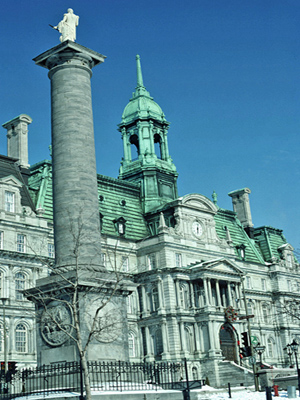Montréal City Hall National Historic Site of Canada
Montréal, Quebec

General view
© Parks Canada Agency / Agence Parcs Canada, P St. Jacques, 1994.
Address :
275 Notre-dame Street East, Montréal, Montréal, Quebec
Recognition Statute:
Historic Sites and Monuments Act (R.S.C., 1985, c. H-4)
Designation Date:
1984-11-23
Dates:
-
1872 to 1878
(Construction)
-
1922 to 1926
(Significant)
-
1932 to 1932
(Significant)
Event, Person, Organization:
-
H.M. Perrault
(Architect)
-
Alex C. Hutchinson
(Architect)
-
J.A.L. Lafrenière
(Architect)
-
Laberge et Fils
(Builder)
Other Name(s):
-
Montréal City Hall
(Designation Name)
Research Report Number:
Town Hall Study - 1984
Plaque(s)
Existing plaque: 275 Notre-dame Street East, Montréal, Quebec
This Second Empire styled building was the first in Canada constructed solely to accommodate a city government. Built between 1872 and 1878 to the plans of the architects H.-M. Perrault and A.C. Hutchison, it illustrates the growth of the city and its public services towards the end of the 19th century. The interior, rebuilt after a fire in 1922, features a grand hall of honour and a magnificent council chamber which rank among Canada's most lavishly decorated civic spaces. Since its opening, Montréal's city hall has been at the heart of a civic life remarkably rich in personalities and events.
Description of Historic Place
The Montréal City Hall National Historic Site of Canada is a majestic, five-storey stone building built in the Second Empire style between 1872 and 1878. The grand scale of the exterior is repeated in the interior, where over half of the original space was devoted to ceremonial functions. After a devastating fire in 1922, the interior of the building was largely rebuilt, a fifth storey was added, and the central tower redesigned. In 1932, an addition was constructed at the rear of the building. The building occupies a prominent site on a height of land, completing Montréal’s historic Place Jacques-Cartier on the north. The formal recognition consists of the building on its legal property at the time of designation.
Heritage Value
The Montréal City Hall was designated a national historic site of Canada in 1984 because: it was the first city hall to have been constructed in Canada solely for municipal administration, illustrating the increase in urban population and municipal services at the end of the 19th century; it was designed in the Second Empire style and possesses an interior distinguished by a magnificent hall of honour and council chambers, among the most richly decorated in Canada.
As the country’s first large scale solely administrative city hall building, the Montréal City Hall responded to increasing population during the late 19th century and the increasing complexity of municipal administration. Its location on Place Jacques-Cartier, in the heart of the expanding financial district, reflects the city’s changing economy and the diminishing importance of the city’s port area, where the first city hall was located.
The large scale of the building and the choice of the Second Empire style allowed the city to project its importance in North American trade and commerce, to showcase local craftsmanship, and to celebrate its French heritage. It was the first major public building to adopt the style in Canada, and remains one of the finest examples of the style. Renovations, including those conducted after a fire in 1922, have respected the original architectural vocabulary of the design.
Source: Historic Sites and Monuments Board of Canada, Minutes, November 1984.
Character-Defining Elements
Key elements which relate to the heritage value of Montréal City Hall include: its siting on a rise at the top of Place Jacques-Cartier, looking toward the port; its Second Empire style evident in the steep, metal-clad mansard roofs, extensive use of dormers to enliven the roofline, its symmetrical façade dominated by a projecting, two-storey pedimented entrance pavilion and flanking end pavilions, its prominent stringcourses dividing each storey, and its classical decorative vocabulary; its rich elaborations including the double-height, columned portico, central clock, elaborate chimneys, and domed cupola; its fine masonry work; its axial interior layout with large public spaces finished with sumptuous materials such as French marble for floors and walls; its hall of honour, with its ornate materials and decoration, including Italian green marble, French Art Deco lamps and bronze-and-glass chandelier, hand-carved ceiling, and five stained-glass windows representing religion, the port, industry and commerce, finance, and transportation; its council chambers, with its elegant detailing, including the ornate ceiling, wooden panelling, and stained-glass windows.